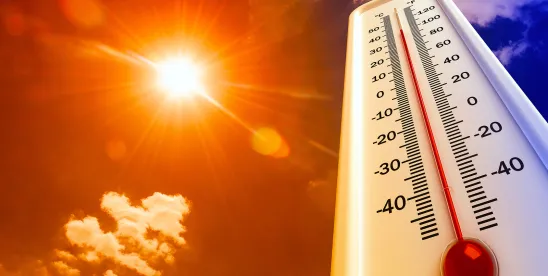On July 16, 2025, U.S. Senator Alex Padilla (D-CA) introduced the “Asunción Valdivia Heat Illness, Injury, and Fatality Prevention Act of 2025” (S.2298)—also known as the “Heat Illness Prevention Act of 2025” (HIPA)—to direct the secretary of labor “to promulgate an occupational safety and health standard to protect workers from heat-related injuries and illnesses.”
If enacted as proposed, HIPA would mandate that employers provide workplaces free from hazardous heat conditions, comply with new standards, and implement comprehensive programs of protective measures. The legislation outlines the process for rulemaking, enforcement, and employee protection, with a strong emphasis on worker safety, transparency, and participation.
Quick Hits
- Newly introduced congressional legislation would require the Occupational Safety and Health Administration (OSHA) to establish and enforce a standard to protect workers from occupational exposure to hazardous heat conditions in the workplace.
- Under the proposed Heat Illness Prevention Act of 2025, the secretary of labor would be required to promulgate a standard directing employers to implement, at their expense, safety and health measures—including engineering controls, administrative adjustments, personal protective equipment, health protocols, training, and planning requirements—to protect indoor and outdoor workers from heat-related injuries and illnesses.
- The legislation sets strict deadlines for rulemaking, extends the statute of limitations for citations to four years, and ensures all training materials are provided in languages understood by employees, offering more robust protections than the current OSHA heat injury and illness prevention rulemaking.
HIPA would compel employers to provide employment and workplaces free from conditions that could reasonably cause death or serious harm from heat stress and comply with all standards, regulations, and orders issued under the act.
Under HIPA, the secretary of labor would be compelled to promulgate a standard based on the best available evidence, prioritizing worker protection. The standard would be required to include the following elements:
- Engineering controls, such as isolation, shielding, ventilation, insulation, or climate-control technologies, to eliminate hazardous heat conditions
- Administrative controls, including adjustments to work procedures, schedules, or practices to limit heat exposure
- Personal protective equipment that would include the provision of cooling garments, heat-reflective clothing, and similar equipment at the employer’s expense
- Health-related protocols, including medical monitoring, emergency response, medical removal protection, and training for recognizing and responding to heat illness
- Training requirements for employees and supervisors to be trained in heat illness symptoms, emergency procedures, and their rights
- Planning requirements for employers to develop, update, and implement written heat illness and injury prevention plans with employee participation
- Core practices, including access to cool potable water or appropriate hydration, paid rest breaks, shade or cool-down spaces, acclimatization policies, and other necessary measures
- Protection of pay during rest breaks, medical removal, and training
- Language accessibility for all required materials and training
- No reduction in existing worker protections
HIPA also includes mandates related to the rulemaking that the secretary of labor would be compelled to undertake, including the required issuance of an interim final rule within one year of HIPA’s enactment, effective immediately. It also provides for public petitions, timelines for proposed and final standards, and “transparency” in the rulemaking process. HIPA would limit venue for judicial review to the U.S. Court of Appeals for the District of Columbia Circuit, with strict filing deadlines.
The rule created by the mandates set forth in HIPA would have the same legal effect as rules promulgated under the Occupational Safety and Health Act of 1970, with some interesting exceptions, most notable of which is that citations for violations could be issued up to four years after an occurrence, which is a vast expansion of the current six months from the date an inspection is opened. A severability clause ensures the rest of the act remains effective if any part is invalidated.
How Does HIPA Compare With OSHA’s Heat Injury and Illness Prevention Program Rulemaking?
Both HIPA and OSHA’s proposed Heat Injury and Illness Prevention Program rule aim to protect workers from heat-related hazards by establishing enforceable standards. HIPA, however, legislatively mandates the creation of such a standard, whereas the OSHA rule is an administrative action under existing authority. HIPA is prescriptive in requiring engineering and administrative controls, personal protective equipment, health protocols, training, and planning. In contrast, the proposed OSHA rule is expected to include similar elements, but flexibility exists to allow the final rule to exclude elements not deemed appropriate for inclusion.
While HIPA sets strict deadlines and requirements for interim and final rules, public participation, and transparency in rulemaking, OSHA’s rulemaking process is governed by the Administrative Procedure Act and does not have the same statutory deadlines or transparency mandates. Both provide for enforcement by and through OSHA, but HIPA extends the statute of limitations for citations to four years and provides additional whistleblower protections. HIPA emphasizes meaningful employee participation in developing and updating heat illness prevention plans, which is a more robust obligation than what is required under OSHA’s proposed Heat Injury and Illness Prevention Program rulemaking.
While OSHA has issued letters of interpretation or standard interpretations indicating that employers are obligated to provide training materials in languages understood by their workforces, HIPA requires all materials and training to be provided in languages understood by employees. HIPA also prohibits any reduction in existing protections, ensuring that a new standard will not weaken current state or federal requirements.
Key Takeaways
In summary, as proposed, HIPA would codify and strengthen requirements for protecting workers from heat hazards, providing a legislative framework that is likely more detailed, prescriptive, and protective than OSHA’s proposed Heat Injury and Illness Prevention Program rule, which is still under development and subject to the regulatory process.



 />i
/>i
